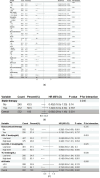Effects of non-HDL-C and statin therapy on mortality in ARDS: a retrospective cohort study
- PMID: 40809441
- PMCID: PMC12345366
- DOI: 10.3389/fmed.2025.1594164
Effects of non-HDL-C and statin therapy on mortality in ARDS: a retrospective cohort study
Abstract
Background: Acute respiratory distress syndrome (ARDS) is a critical and potentially fatal condition marked by inflammation and coagulation disorders. Statins, a class of cholesterol-lowering medications, have been explored for potential anti-inflammatory properties, yet their exact role in ARDS remains unclear.
Methods: Patients diagnosed with ARDS were sourced from the MIMIC-IV database (version 3.0). To balance baseline characteristics, propensity score matching (PSM) was applied. Short-term mortality was evaluated using Kaplan-Meier survival analysis. Factors associated with short-term mortality were determined using both univariate and multivariate Cox regression analyses. The potential impact of unmeasured confounding was assessed using the E-value. Additionally, subgroup analyses were performed to investigate heterogeneity and evaluate the robustness of the findings.
Results: The study included 10,368 ARDS patients, of whom 5,184 received statin therapy and 5,184 did not. Kaplan-Meier analysis revealed significantly lower short-term mortality in the statin-treated group. Both univariate (HR, 0.48; 95% CI, 0.41-0.58; p < 0.001) and multivariate (HR, 0.49; 95% CI, 0.41-0.58; p < 0.001) Cox regression analyses revealed that statin therapy significantly decreased short-term mortality. Subsequent subgroup analyses further indicated that the beneficial effect of statins was more evident in patients with elevated non-HDL-C levels.
Conclusion: Statin therapy appears to confer significant clinical benefits in ARDS patients, particularly in those with high non-HDL-C levels. These findings indicate that non-HDL-C might be a useful marker for identifying ARDS patients who may benefit most from statin therapy.
Keywords: ARDS; MIMIC-IV database; clinical prognosis; non-HDL-C; statin.
Copyright © 2025 Hu, Wei, Zhao, Zhu, Zhou, Zhao and Chang.
Conflict of interest statement
The authors declare that the research was conducted in the absence of any commercial or financial relationships that could be construed as a potential conflict of interest.
Figures



Similar articles
-
Prescription of Controlled Substances: Benefits and Risks.2025 Jul 6. In: StatPearls [Internet]. Treasure Island (FL): StatPearls Publishing; 2025 Jan–. 2025 Jul 6. In: StatPearls [Internet]. Treasure Island (FL): StatPearls Publishing; 2025 Jan–. PMID: 30726003 Free Books & Documents.
-
Systemic pharmacological treatments for chronic plaque psoriasis: a network meta-analysis.Cochrane Database Syst Rev. 2021 Apr 19;4(4):CD011535. doi: 10.1002/14651858.CD011535.pub4. Cochrane Database Syst Rev. 2021. Update in: Cochrane Database Syst Rev. 2022 May 23;5:CD011535. doi: 10.1002/14651858.CD011535.pub5. PMID: 33871055 Free PMC article. Updated.
-
Comparison of Two Modern Survival Prediction Tools, SORG-MLA and METSSS, in Patients With Symptomatic Long-bone Metastases Who Underwent Local Treatment With Surgery Followed by Radiotherapy and With Radiotherapy Alone.Clin Orthop Relat Res. 2024 Dec 1;482(12):2193-2208. doi: 10.1097/CORR.0000000000003185. Epub 2024 Jul 23. Clin Orthop Relat Res. 2024. PMID: 39051924
-
The effectiveness and cost-effectiveness of carmustine implants and temozolomide for the treatment of newly diagnosed high-grade glioma: a systematic review and economic evaluation.Health Technol Assess. 2007 Nov;11(45):iii-iv, ix-221. doi: 10.3310/hta11450. Health Technol Assess. 2007. PMID: 17999840
-
Systemic treatments for metastatic cutaneous melanoma.Cochrane Database Syst Rev. 2018 Feb 6;2(2):CD011123. doi: 10.1002/14651858.CD011123.pub2. Cochrane Database Syst Rev. 2018. PMID: 29405038 Free PMC article.
References
-
- Fan E, Del Sorbo L, Goligher EC, Hodgson CL, Munshi L, Walkey AJ, et al. American Thoracic Society, European Society of Intensive Care Medicine, and Society of Critical Care Medicine (2017). An Official American Thoracic Society/European Society of Intensive Care Medicine/Society of Critical Care Medicine Clinical Practice Guideline: Mechanical Ventilation in Adult Patients with Acute Respiratory Distress Syndrome. Am J Respir Crit Care Med. 195, 1253–1263. doi: 10.1164/rccm.201703-0548ST - DOI - PubMed
LinkOut - more resources
Full Text Sources
Miscellaneous

